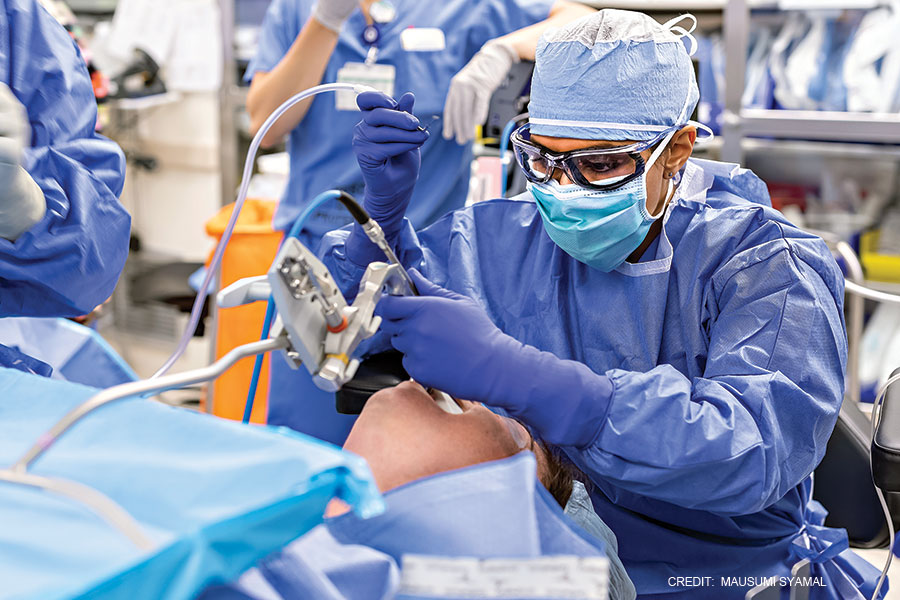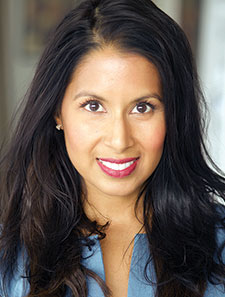
Laryngology enables Dr. Syamal to apply her love of engineering, fluid dynamics, and the physics of vibrations to the clinical pathology and ENT disease conditions she treats.
In our fast-paced and interconnected world, the feeling of urgency to achieve a goal can deflect our attention from the ways in which less traditional and more indirect paths can lead to inspired, even exceptional, results. The story of Dr. Mausumi Syamal’s path to otolaryngology provides the perfect reminder of how a nonconformist approach to medicine can sometimes lead to such an outcome. As a mechanical engineer and a former young-executive path hire at General Motors who once also pursued a career on Broadway, Dr. Syamal’s career path defies convention.
While one may think her affinity for laryngology stems from her personal background in musical theater, that’s only part of her story. Ultimately, laryngology enables Dr. Syamal to apply her love of engineering, fluid dynamics, and the physics of vibrations to the clinical pathology and ENT disease conditions she treats.
If you have the good fortune of hearing her describe a seemingly simple concept like why mucous amasses on a scar on the vocal folds, you may walk away from the conversation feeling a little inspired—her infectious enthusiasm for engineering may rub off on you as it did on me. “It’s because of eddy currents,” she told me. “Eddy currents” are loops of swirling currents that move counter to a main current. “When the velocity of airflow reaches a stagnation point, fluid will inherently collect. A scar within a vocal fold serves as a stagnation point.”
As someone who has observed mucous sticking to scars and vocal fold nodules during a laryngoscopy but has never quite understood the physics behind the clinical observation, a light bulb went on as I realized that the change in the surface of the mucosa was impacting the forces affecting how and where the mucous moved.
This interview was condensed and edited for clarity.
Dr. Rapoport: Dr. Syamal, your path to medicine and ENT took a nontraditional path. What drove you to study engineering before medicine?
Dr. Syamal: I was the child of first-generation immigrants from India. My parents traveled first to Canada, where they completed their own college educations, and then came to the U.S. Education was deeply ingrained in them. It was not only important to them that I study hard, but also that whatever I chose to do, I apply myself intently to it. That was the motto of our home.
My parents were engineers. In our home, engineering was the way we thought about the world. For example, as a child, I had a female superhero doll. The cool thing about her was that she had mechanical peacock wings that would flap out of her back. One day, her peacock wings stopped working. Of course, I found this issue very upsetting. I took the doll to my dad and told him what had happened. Instead of immediately offering to fix it, he suggested I sit down with the doll and try taking it apart to see if I could figure out why the mechanism was failing. The process felt brutal to a young girl. I remember sitting with all eight mechanical parts arrayed in front of me. It took me an entire month to solve the issue, but in the end, I was able to fix it. This was very powerful. I was of course proud of myself and felt a sense of accomplishment. But more than that, what this exercise really taught me was the importance of patience and understanding.
So few things in our daily lives come with an instruction manual. My dad was teaching the young me how, by deliberately and purposefully sitting down to solve the problem in front of me, I was enabling myself to develop an elegant solution.
Dr. Rapoport: What was it like to be a woman studying engineering?
Dr. Syamal: In a household of engineers, engineering was simply what I knew, so it felt like a natural path for me to choose mechanical engineering when I went to college at Duke University. And studying engineering was probably one of the most wonderful experiences of my life.
My first year was really hard. I even got my first C! But I ended up being one of two women who graduated with honors from Duke’s engineering college. In fact, I liked studying engineering so much that I went on to complete a master’s in mechanical engineering at the University of Michigan, focusing on fluid flow and thermodynamics.
Dr. Rapoport: Where did that second degree take you?
Dr. Syamal: After I graduated, I took a job working at General Motors (GM) as an aero-thermal engineer. While working at GM, I also volunteered at a needle exchange program in Ann Arbor. At the time, we were trying to reduce the spread of HIV/AIDS within the population there. I really enjoyed the frontline nature of this work. You see, I always had medicine as an interest in the back of my mind. So much so that I had completed most of my pre-med courses while I was still an undergraduate. After I had been working at GM for two years, I decided to apply to medical school.
Working at GM may seem disconnected from medicine, but those years were ultimately quite informative for me. The leadership style and skills I use today are strongly influenced by my time at GM. While I was there, I completed a managerial and leadership program that required each aspiring manager to spend time working in every role performed by each member of the team they were leading. This unusual step meant that even though I was an engineer, I spent two weeks working in every single job of the people whom I managed. This involved welding metal on an assembly line, performing crash testing and test driving, and even selling a car on a car lot! This varied experience taught me how much nuance and value each member of your team can provide. I try to never forget that.
Dr. Rapoport: Wasn’t there also a period in your life before medicine when you were a performer on Broadway in New York City?
Dr. Syamal: Yes. The summer before beginning medical school, I went to New York City with my acting coach and manager to audition for various acting opportunities. Ironically, I didn’t have many callbacks until right before I was supposed to start medical school. It was then that I landed a part in the chorus of a major Broadway musical. It was a difficult decision for me, but because I had avidly been looking forward to beginning medical school, I decided not to postpone it any further. So my brief Broadway stint ended there—basically before it started.
Dr. Rapoport: How have you approached moments of adversity during your training and early career? Are there moments of adversity that you think about even today?
Dr. Syamal: Absolutely. A major obstacle I faced was during my residency when my mom died. My mom was my best friend. And one day, during my PGY2 year when I was post-call, we ended up needing to withdraw her care. That was probably one of the hardest times in my life. I had to recalibrate my life to adjust to living in a world in her absence. Residency is already such a profound and fundamental experience. It felt overwhelming for my personal identity to shift to become someone whose mother had died, while also building the foundation of my professional identity and future career.
At the same time, that most difficult time also helped reinforce a fundamental aspect of my personality: I am an optimist. I am a person who seeks out and seeks to choose joy. It is a logical calculus. There are so many factors around us we cannot control. For instance, you cannot control if someone is going to value your work as a physician or the role you bring to a medical team. But if you do your absolute best, if you value yourself, if you model and teach the trainees you mentor to value one another, you may find that that frame of mind intrinsically draws joy and optimism into the medical dynamic. I see it as my job to model joy and optimism, in addition to clinical ability, as a practicing laryngologist.
Dr. Rapoport: This is an aspirational model for us all. Thank you, Dr. Syamal.
Dr. Rapoport is an assistant professor at Georgetown University and an attending physician in otolaryngology/head and neck surgery at the Veterans Affairs Medical Center in Washington, D.C.
Dr. Syamal is the new director of the Philadelphia Voice & Airway Institute in Philadelphia in collaboration with Robert T. Sataloff, MD, DMA, and the department of otolaryngology–head and neck surgery at Drexel University College of Medicine, where she will be actively involved in teaching and research.
